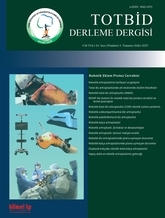
Total hip arthroplasty (THA) is an effective method for the treatment of end-stage degenerative joint disease. Long-term results of THA and durability of the implants depend on correct restoration of hip biomechanics, which is achieved through optimal component positioning. Suboptimal component positioning leads to joint instability, increased wear, and poor functional outcomes. Robotic-assisted arthroplasty has the potential to improve clinical outcomes by providing accurate preoperative planning, optimal implant selection, minimally invasive surgery, precise osteotomy, and accurate component placement.